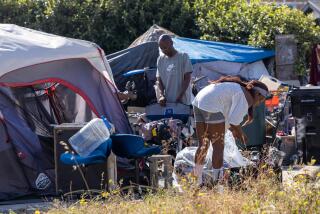U.S. homelessness up 18% as affordable housing remains out of reach for many people

- Share via
BOSTON — The United States saw an 18.1% increase in homelessness this year, a rise driven by a lack of affordable housing as well as devastating natural disasters and a surge of migrants in several parts of the country, federal officials said Friday.
The U.S. Department of Housing and Urban Development said federally required tallies taken across the country in January counted more than 770,000 people as homeless — a number that misses some people and does not include those staying with friends or family because they do not have a place of their own.
That increase comes on top of a 12% increase in 2023, which HUD blamed on soaring rents and the end of pandemic assistance. The 2023 increase also was driven by people experiencing homelessness for the first time. The numbers overall represent 23 of every 10,000 people in the U.S., with Black people being overrepresented among the homeless population.
“No American should face homelessness, and the Biden-Harris Administration is committed to ensuring every family has access to the affordable, safe, and quality housing they deserve,” Adrianne Todman, the acting secretary of HUD, said in a statement, adding that the focus should remain on “evidence-based efforts to prevent and end homelessness.”
Among the most concerning trends was a nearly 40% rise in family homelessness — one of the areas that was most affected by the arrival of migrants in big cities. Family homelessness more than doubled in 13 communities affected by migrants, including Denver, Chicago and New York City, according to HUD, while it rose less than 8% in the remaining 373 communities. Nearly 150,000 children experienced homelessness on a single night in 2024, reflecting a 33% jump from last year.
Disasters also played a part in the rise in the count, especially last year’s catastrophic Maui wildfire, the deadliest U.S. wildfire in more than a century. More than 5,200 people were staying in emergency shelters in Hawaii on the night of the count.
“Increased homelessness is the tragic, yet predictable, consequence of underinvesting in the resources and protections that help people find and maintain safe, affordable housing,” Renee Willis, incoming interim chief executive of the National Low Income Housing Coalition, said in a statement. “As advocates, researchers, and people with lived experience have warned, the number of people experiencing homelessness continues to increase as more people struggle to afford sky-high housing costs.”
The numbers also come as increasing numbers of communities are taking a hard line against homelessness.
Angered by often dangerous and dirty tent camps, communities — especially in Western states — have been enforcing bans on camping. That follows a 6-3 ruling last year by the Supreme Court that found that outdoor sleeping bans don’t violate the 8th Amendment. Homeless advocates argued that punishing people who need a place to sleep would criminalize homelessness.
There was some positive news in the count, as homelessness among veterans continued to trend downward. The number of homeless veterans dropped 8% to 32,882 in 2024. It was an even larger decrease for unsheltered veterans, declining 11% to 13,851 in 2024.
“The reduction in veteran homelessness offers us a clear road map for addressing homelessness on a larger scale,” Ann Oliva, CEO of the National Alliance to End Homelessness, said in a statement. “With bipartisan support, adequate funding, and smart policy solutions, we can replicate this success and reduce homelessness nationwide. Federal investments are critical in tackling the country’s housing affordability crisis and ensuring that every American has access to safe, stable housing.”
Several large cities had success bringing down their homeless numbers. Dallas, which worked to overhaul its homeless system, saw a 16% drop in its numbers between 2022 to 2024. Los Angeles, which increased housing for homeless people, saw a drop of 5% in unsheltered homelessness since 2023. California, the most populous state in the U.S., continued to have the nation’s largest homeless population, followed by New York, Washington, Florida and Massachusetts.
The sharp increase in the homeless population over the last two years contrasts with the success the U.S. had been having for more than a decade.
Going back to the first 2007 survey, the U.S. made steady progress for about a decade in reducing the homeless population as the government focused particularly on increasing investments to get veterans into housing. The number of homeless people dropped from about 637,000 in 2010 to about 554,000 in 2017.
The numbers ticked up to about 580,000 in the 2020 count and held relatively steady over the next two years as Congress responded to the COVID-19 pandemic with emergency rental assistance, stimulus payments, aid to states and local governments and a temporary eviction moratorium.
Casey writes for the Associated Press.
More to Read
Sign up for Essential California
The most important California stories and recommendations in your inbox every morning.
You may occasionally receive promotional content from the Los Angeles Times.










